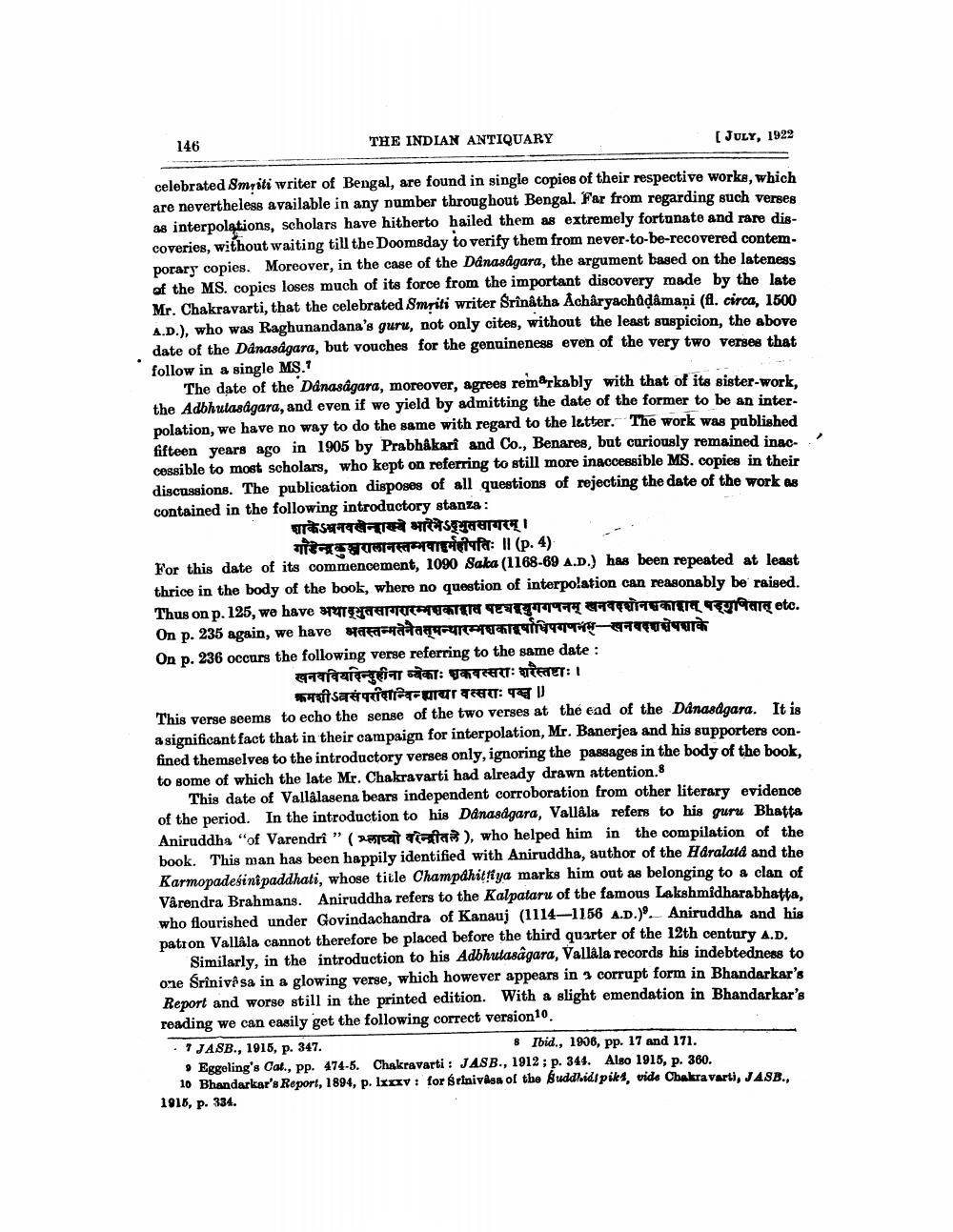________________
146
THE INDIAN ANTIQUARY
[JULY, 1922
celebrated Smriti writer of Bengal, are found in single copies of their respective works, which are nevertheless available in any number throughout Bengal. Far from regarding such verses as interpolations, scholars have hitherto hailed them as extremely fortunate and rare discoveries, without waiting till the Doomsday to verify them from never-to-be-recovered contemporary copies. Moreover, in the case of the Dânasagara, the argument based on the lateness of the MS. copies loses much of its force from the important discovery made by the late Mr. Chakravarti, that the celebrated Smriti writer Srinatha Acharyachtḍâmani (fl. circa, 1500 A.D.), who was Raghunandana's guru, not only cites, without the least suspicion, the above date of the Dânasagara, but vouches for the genuineness even of the very two verses that follow in a single MS."
The date of the Dânasagara, moreover, agrees remarkably with that of its sister-work, the Adbhulasagara, and even if we yield by admitting the date of the former to be an interpolation, we have no way to do the same with regard to the latter. The work was published fifteen years ago in 1905 by Prabhâkarî and Co., Benares, but curiously remained inac cessible to most scholars, who kept on referring to still more inaccessible MS. copies in their discussions. The publication disposes of all questions of rejecting the date of the work as contained in the following introductory stanza:
थाकेनन् भनेऽनुतसागरम् ।
गोदना कुञ्जरालास्तम्भयाइहीपतिः॥ (p. 4)
For this date of its commencement, 1090 Saka (1168-69 A.D.) has been repeated at least thrice in the body of the book, where no question of interpolation can reasonably be raised. Thus on p. 125, we have अथाद्भुतसागरारम्भशकाद्वात पष्टघइयुगगणनम् खनवदशोनश्चकाद्दात् षड्गुणितात् etc. On p. 235 again, we have भवस्तम्भतेने तस्यन्यारम्भचकाइर्षाभिपयन सनवरपाके
On p. 236 occurs the following verse referring to the same date:
खनववियदिन्दुहीना व्येकाः चकवत्सराः शरैस्तष्टाः । क्रमशीऽवसं परशिन्विन्ह्याचा वत्सराः पच ॥
This verse seems to echo the sense of the two verses at the end of the Dânasagara. It is a significant fact that in their campaign for interpolation, Mr. Banerjea and his supporters confined themselves to the introductory verses only, ignoring the passages in the body of the book, to some of which the late Mr. Chakravarti had already drawn attention.8
This date of Vallâlasena bears independent corroboration from other literary evidence of the period. In the introduction to his Dânasågara, Vallâla refers to his guru Bhatta Aniruddha "of Varendri" (ata), who helped him in the compilation of the book. This man has been happily identified with Aniruddha, author of the Háralata and the Karmopadesini paddhati, whose title Champåhittiya marks him out as belonging to a clan of Vârendra Brahmans. Aniruddha refers to the Kalpataru of the famous Lakshmidharabhatta, who flourished under Govindachandra of Kanauj (1114-1156 A.D.). Aniruddha and his patron Vallâla cannot therefore be placed before the third quarter of the 12th century A.D.
Similarly, in the introduction to his Adbhutasagara, Vallala records his indebtedness to one Srinivasa in a glowing verse, which however appears in a corrupt form in Bhandarkar's Report and worse still in the printed edition. With a slight emendation in Bhandarkar's reading we can easily get the following correct version 10.
7 JASB., 1915, p. 347.
8 Ibid., 1906, pp. 17 and 171.
Eggeling's Cat., pp. 474-5. Chakravarti: JASB., 1912; p. 344. Also 1915, p. 360. 10 Bhandarkar's Report, 1894, p. lxxxv: for Srinivasa of the Buddhidi piks, vide Chakravarti, JASB., 1915, p. 334.




